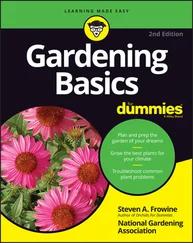This book is full of tips and other pieces of helpful advice you can use as you start growing and caring for your own orchids. If you want some additional tidbits of wisdom, check out the book’s Cheat Sheet at www.dummies.com . Just search for “Orchids For Dummies Cheat Sheet.”
This book is set up in digestible, stand-alone pieces. Pick out sections that interest you most and read them first. You can bounce around in the book any way you please.
If you already have orchids but are having difficulties growing them, you may want to start out with Part 4. It gives you quick answers to common problems.
Trying to decide which orchid you should start with? Look at Chapters 2and 15. To get jazzed about orchids, check out the color insert. And if you have an orchid that is in dire need of repotting, skip right to Chapter 7.
If you’re not sure where to begin, scan the Table of Contents or index for a topic that piques your interest, flip to the chapter, and start reading.
Part 1
Welcoming Orchids into Your Life
IN THIS PART …
Grow orchids to change your life — forever! It has for me and many people. No other plant family offers the number and diversity of breathtaking and intriguing flowers that orchids do.
Enjoying these fabulous plants used to be only for the eyes of royalty or well-heeled aristocrats.
Find out how you can buy an orchid plant in full bloom for less than you would pay for a bouquet of flowers from the florist.
Discover which orchids are less expensive and easy to grow and flower in windowsills and under artificial lights.
Join me in this part as I introduce you to this marvelous plant family. This is going to be a fun journey!
Chapter 1
Discovering the World of Orchids
IN THIS CHAPTER
 Exploring this colorful unique group of plants
Exploring this colorful unique group of plants
 Deciding whether orchids are right for you
Deciding whether orchids are right for you
 Knowing what to do for your orchids each month of the year
Knowing what to do for your orchids each month of the year
You’re about to encounter a marvelous group of plants called orchids. You’re in store for an exciting adventure! This is one of the largest plant families on the planet with an estimated 30,000 wild types (species) and many more human-made varieties (known as hybrids ). No other plants can compete with orchids for their power to seduce and bedazzle the most jaded plant lover with their fantastically beautiful flower colors, shapes, and textures, and heady and sensuous perfumes.
This chapter serves as your launch pad to the diverse world of orchids. They’re unparalleled in their marvelous array of flower colors and shapes not to mention their alluring, fragrances. Here I reveal some of the many mysteries of these exotic plants.
Understanding What Makes an Orchid an Orchid
You can easily tell when a rose is rose, but orchids are quite a bit more complex and varied when it comes to their flower shapes and the construction of their leaves, stems, and roots. In Part 3, I give you lots of information on flower, leaf, and stem construction of specific orchids. In this chapter, I talk generalities.
Certainly, the flamboyant colors of modern orchid hybrids are a standout and are the primary reason these plants are so treasured. But there are so many distinct types of orchid flowers, so the question is, “Which one is typical?” There is no correct answer to this question. Many people think of the cattleya-type orchids (see Chapter 11), whereas others may picture moth orchids (see Chapter 10).
To get a better idea how orchid flowers are constructed, look at a typical cattleya flower and compare it to a more ordinary flower, a tulip (see Figure 1-1). Table 1-1shows some of the major differences between these two flowers.
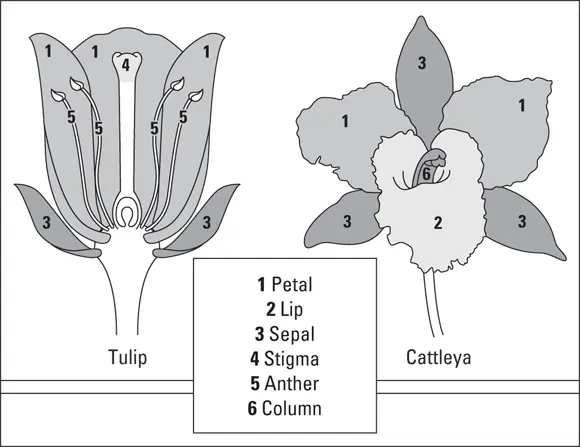
© John Wiley & Sons, Inc.
FIGURE 1-1:Comparing a cattleya flower with a tulip flower.
So, what makes an orchid an orchid? The column. This fused sexual structure located in the middle of the flower is what separates the orchid from all other plants.
TABLE 1-1Differences between Tulip and Orchid Flowers
| Flower Part |
Tulip |
Orchid |
| Petals |
The most obvious part of the flower and what makes a tulip look like a tulip. |
A very prominent part of the flower but comprises only half of the show. |
| Sepals |
Hardly noticeable in the tulip flower, especially after they open. |
Very striking in many orchid flowers. Can be as brightly colored as the petals. |
| Lip or labellum |
Not found in the tulip. |
Usually a very showy part of the orchid flower. Actually, a modified petal. |
| Anther and stigma |
The two sexual parts of the tulip. The anthers are male reproductive organs, and the stigma is the female part. |
These separate organs are not found in the orchid; instead, orchids have a column in which the male and female parts are fused. |
| Column |
Not found in tulip. |
Only found in orchids. |
Knowing Where Orchids Come From
About 80 percent of orchids are from the tropics in both the New World (mostly Central and South America) and the Old World (Asia and Africa). A smattering of mostly hardy orchids can be found in countries with more temperate climates.
The ones that grow in your home, though, are all tropical or semitropical origin. They mostly hail from areas of high rainfall and humidity and enjoy tropical to above-freezing temperatures during the winter.
Orchids are divided into two major categories based on where they grow:
Epiphytes: They’re commonly found clinging to branches of trees. Epiphytes have thick roots (called aerial roots because they’re frequently suspended in the air), which are covered with a silvery material called velamen, which can absorb moisture from the air like a sponge (see Figure 1-2).
Semiterrestrials and terrestrials: They thrive growing on or in the ground. Many of the terrestrial roots are hairy, like those found in the slipper orchid (see Figure 1-3).
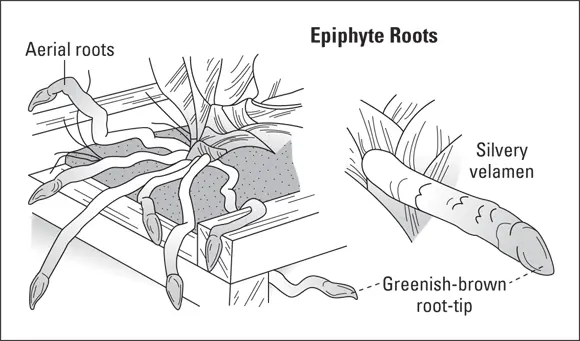
© John Wiley & Sons, Inc.
FIGURE 1-2:Epiphytic orchids have thick roots covered with silver velamen.
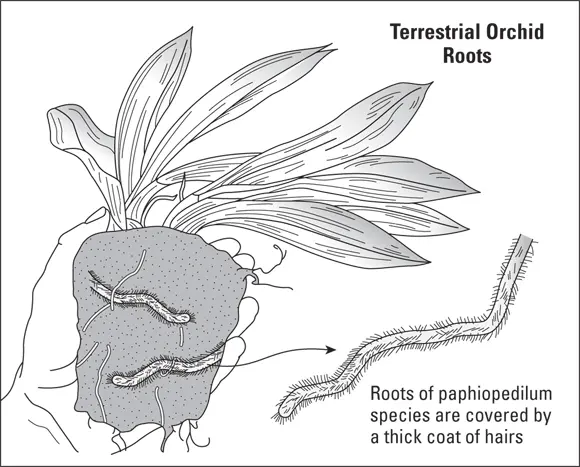
© John Wiley & Sons, Inc.
FIGURE 1-3:Terrestrial and semiterrestrial orchids, like most slipper orchids, frequently have hairy roots.
Seeing Why You Should Grow Orchids
Growing and studying orchids provide you the ultimate horticultural experience and pleasure. Here are some key reasons to start growing orchids now:
Growing orchids is fun! That’s the most important motive.
Читать дальше
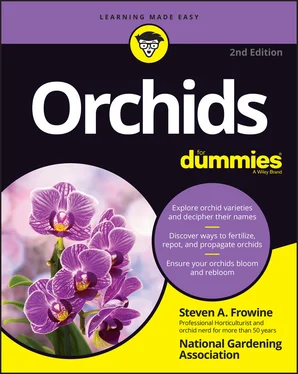
 Exploring this colorful unique group of plants
Exploring this colorful unique group of plants










